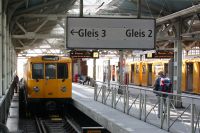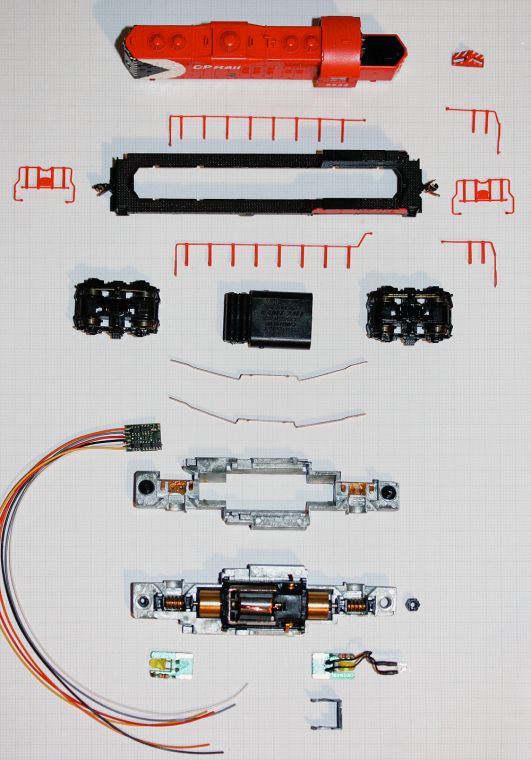Split Frame
Posted: 9 May 2009

This work is licensed under a Creative Commons Germany license.
Notes
In the course of disassembling this Life-Like N-scale GP9 in Canadian Pacific livery, I came across this collection of parts and decided to take a picture because it looks cool. Most of the parts in the upper half should be self-explaining. The lower half is where it gets interesting.
This model uses a so-called “Split Frame” design. The basic metal frame consists of two halves that are screwed together and insulated from each other. Electricity is picked up from the wheels and goes from the trucks via the two metal strips to each half of the frame. The motor is positioned so (a little hard to see here) that one contact is connected with one half of the frame, and the other with the other. The two lighting boards are similarly fitted in the frame. Except for the lighting board, no cables and solder connections are required. Quite ingenious, right?
Wrong. In fact, I never actually wanted to disassemble the locomotive that much. The split-frame designs fails as soon as someone wants to completely re-route all the locomotive’s electricity - say, through the tiny board with the long cables, which is a DCC decoder (Kuehn N025). This enables the locomotive to run with DCC, which means that direction and speed are no longer determined by track voltage, but electronically, and can be set individually for all locomotives on the layout. It makes model railroading at least 60% more fun, but it requires such a decoder (this one: €25), and that all power goes through it. Meaning I have to insulate electricity pickup, motor and/or lighting boards. Not to mention that I’ll have to file off parts of the rear frame to make the decoder fit.
The civilized solution is to have a connector where you just can insert a fitting decoder, but no american N-scale manufacturer seems to want that. Some, e.g. Kato, at least have a single board that all electricity goes through and that you can modify easily or swap out for one that has a decoder on it already. So this means that yes, german model railroads cost more, but you do get actual value for that. Of course, there are also far cheaper model railroads that also have the connector, making this point moot. I’d also complain about changing couplings, which similarly sucks on american model railroads, but installing these Microtrains Body-Mount couplers was actually quite easy.

 Deutsche Version
Deutsche Version Entire Gallery
Entire Gallery

 Next Picture
Next Picture
 Previous Picture
Previous Picture
